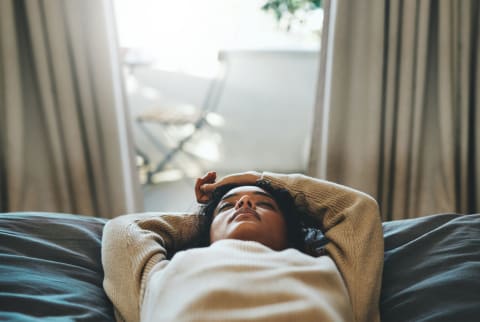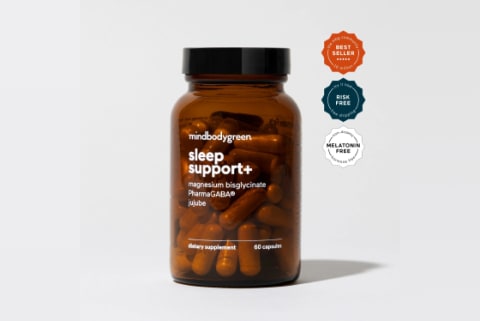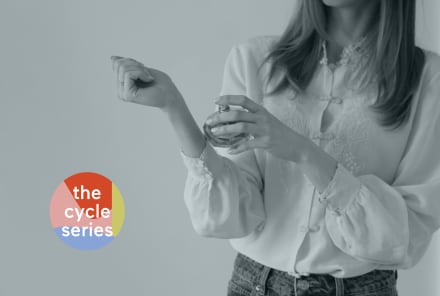Advertisement
Why White Noise Doesn't Actually Help You Sleep + What To Listen To Instead


When you're trying to fall asleep, any stray sound can quickly amplify. Noise machines have become popular sleep tools for masking the squeak of a floorboard in the next room or the honk of cars outside. While we often group all of their steady, fan-like tones together as "white noise," sound and music experts explain that there are actually many different "colors" of noise these machines emit—and white noise is probably the worst for sleep. Here's why, and what color sounds you should seek for your slumber instead.
What is white noise?
Sound theory is super mathematical and technical, but in its most basic form, sound is a combination of wavelengths that have different frequencies, or speeds of vibration. "Noise is a selection of individual frequencies playing in a random distribution," explains Greg McAllister, a senior sound experience manager at Sonos who helps craft the company's sleep stations for Sonos Radio. "The different flavors of noise are how that frequency distribution is weighted across the range."
When all of these different frequencies are weighted equally, you get true white noise. Stanford acoustics researcher and neuroscience adviser at Spiritune Daniel Bowling, Ph.D., explains that this equal weighting of frequencies is very unnatural. That is, it sounds more like the static whir of a machine than anything you'd hear if you stepped outside into a forest or beach. (In nature, higher frequencies are not represented as often.)
"White noise is like television static. If you make that really loud, it's going to be really annoying," Bowling tells mbg. "The high-frequency content will grab your attention, heighten your arousal, and make you anxious."
So he notes that while white noise is often discussed as a gold standard for sleep, it's actually the last thing you'd want to turn on to relax at bedtime.
Which color of noise is better for sleep.
Other colors of noise have different distributions of low and high frequencies—unlike white noise, which represents all frequencies evenly. Pink noise is more weighted toward low frequencies, and it tends to be more appealing to our ears. Compared to white noise, McAllister notes that pink noise sounds smoother and warmer. Instead of the high-pitched static of television, it's more akin to the deep whir of waves lapping on a beach.
"Brown noise takes that even a step further so it's even more heavily weighted toward the low frequencies. That can sound more like a rumble or a thunderstorm," he notes. Since these sounds more closely correlate to what we'd hear out in nature, McAllister says that it makes sense we'd intuitively find them comforting.
Pink noise, in particular, has been shown to be deeply relaxing in lab studies. When we're asleep, our brains are still processing some of the noises of our surrounding environment—our brainwaves can actually sync up with the frequency of the sounds we're hearing1. Some research has found that the deep, low frequencies of pink noise have been shown to ease our brains2 into slow-wave states where recovery and memory consolidation can occur. This means that beyond masking annoying stimulating sounds, pink noise might actually go a step further to improve our overall sleep quality3 and enhance our memory4 in the process.
The bottom line.
Most white noise machines on the market actually play a spectrum of different colors of noise. To achieve deeper sleep, you'll want to choose one that falls more into the pink spectrum of noise and sounds like waves on the beach.
Watch Next
Enjoy some of our favorite clips from classes
Enjoy some of our favorite clips from classes
What Is Meditation?
Mindfulness/Spirituality | Light Watkins
Box Breathing
Mindfulness/Spirituality | Gwen Dittmar
What Breathwork Can Address
Mindfulness/Spirituality | Gwen Dittmar
The 8 Limbs of Yoga - What is Asana?
Yoga | Caley Alyssa
Two Standing Postures to Open Up Tight Hips
Yoga | Caley Alyssa
How Plants Can Optimize Athletic Performance
Nutrition | Rich Roll
What to Eat Before a Workout
Nutrition | Rich Roll
How Ayurveda Helps Us Navigate Modern Life
Nutrition | Sahara Rose
Messages About Love & Relationships
Love & Relationships | Esther Perel
Love Languages
Love & Relationships | Esther Perel
What Is Meditation?
Box Breathing
What Breathwork Can Address
The 8 Limbs of Yoga - What is Asana?
Two Standing Postures to Open Up Tight Hips
How Plants Can Optimize Athletic Performance
What to Eat Before a Workout
How Ayurveda Helps Us Navigate Modern Life
Messages About Love & Relationships
Love Languages
Advertisement

This Type Of Fat Is Vital For Women's Health — Are You Getting Enough?
Molly Knudsen, M.S., RDN

New Study Confirms The 3 Habits That Age Your Brain Faster
Molly Knudsen, M.S., RDN

This Type Of Fat Is Vital For Women's Health — Are You Getting Enough?
Molly Knudsen, M.S., RDN

New Study Confirms The 3 Habits That Age Your Brain Faster
Molly Knudsen, M.S., RDN














